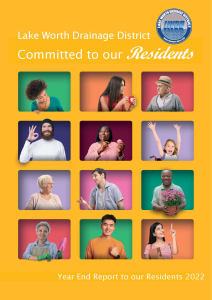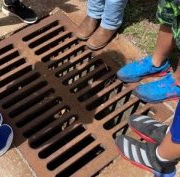Be Proactive With Drainage
/in Flood Control, News, ResidentialCome rain or shine, the Lake Worth Drainage District (LWDD) oversees the operation and maintenance of approximately 500 miles of canals. Throughout the year LWDD operates 20 major water control structures in order to release or hold back water depending on conditions. However, effective flood control takes more than just LWDD. Property owners also have a role to play in the overall flood control system.
In South Florida, flood control is a shared responsibility and is achieved through an interconnected, three-tiered drainage system. This three-tiered system is made up of tertiary or neighborhood drainage systems operated by property owners or residential associations. Secondary drainage systems are operated by LWDD, county or municipalities, and the primary system operated by regional water management entities like the South Florida Water Management District (SFWMD).
The role of property owners and residential associations is like LWDD in that they manage stormwater within their property boundary. They achieve this with the use of swales and stormwater ponds. The swales and ponds provide both water quality and flood control functions. Property owners and residential associations must maintain their drainage infrastructure to ensure that swales, catch basins, underground pipes and discharge control structures are working as designed.
South Florida’s dry season runs from approximately October to May. This time of the year is ideal to conduct inspections of drainage infrastructure and make any necessary repairs. Additionally, January and April are when many residential boards hold elections and may change property management companies. LWDD requires that these changes be provided to us as soon as possible. This will ensure the correct individuals are receiving important weather alerts and flood control instructions.
As leaders in your community, do not be caught off guard with drainage failures. Be proactive during this dry season to ensure that your infrastructure is ready for the coming rains. For more information and to submit your contact information, visit www.lwdd.net/property-managers-hoa.
Five Ways Lightning Strikes People
/in News, ResidentialReprint from the NOAA National Weather Service at https://www.weather.gov/safety/lightning-struck
It is not always possible to know exactly how a victim has been struck by lightning, but here is a list of ways that lightning strikes its victims. Any of these types of strikes can be deadly. Immediate medical attention, including calling 911, starting CPR, and using an AED, may be critically important to keep the person alive until more advanced medical care arrives.
Direct Strike
A person struck directly by lightning becomes a part of the main lightning discharge channel. Most often, direct strikes occur to victims who are in open areas. Direct strikes are not as common as the other ways people are struck by lightning, but they are potentially the deadliest. In most direct strikes, a portion of the current moves along and just over the skin surface (called flashover) and a portion of the current moves through the body–usually through the cardiovascular and/or nervous systems. The heat produced when lightning moves over the skin can produce burns, but the current moving through the body is of greatest concern. While the ability to survive any lightning strike is related to immediate medical attention, the amount of current moving through the body is also a factor.
Side Flash
A side flash (also called a side splash) occurs when lightning strikes a taller object near the victim and a portion of the current jumps from taller object to the victim. In essence, the person acts as a “short circuit” for some of the energy in the lightning discharge. A side flash generally occurs when the victim is within a foot or two of the object that is struck. Most often, side flash victims have taken shelter under a tree to avoid rain or hail.
Ground Current
When lightning strikes a tree or other object, much of the energy travels outward from the strike, in and along the ground surface. This is known as the ground current. Anyone outside near a lightning strike is potentially a victim of ground current. In addition, ground current can travel in garage floors with conductive materials. Because the ground current affects a much larger area than the other causes of lightning casualties, the ground current causes the most lightning deaths and injuries. Ground-current also kills many farm animals. Typically, lightning enters the body at the contact point closest to the lightning strike, travels through the cardiovascular and/or nervous systems, and exits the body at the contact point farthest from the lightning. The greater the distance between contact points, the greater the potential for death or serious injury. Because large farm animals have a relatively large body-span, ground current from a nearby lightning strike is often fatal to livestock.
Conduction
Lightning can travel long distances in wires or other metal surfaces. Metal does not attract lightning, but it provides a path for lightning to follow. Most indoor lightning casualties and some outdoor casualties are due to conduction. Whether inside or outside, anyone in contact with anything connected to metal wires, plumbing, or metal surfaces that extend outside is at risk. This includes anything that plugs into an electrical outlet, water faucets and showers, corded phones, and windows and doors.
Streamers
While not as common as the other types of lightning injuries, people caught in “streamers” are at risk of being killed or injured by lightning. Streamers develop as the downward-moving leader approaches the ground. Typically, only one of the streamers makes contact with the leader as it approaches the ground and provides the path for the bright return stroke; however, when the main channel discharges, so do all the other streamers in the area. If a person is part of one of these streamers, they could be killed or injured during the streamer discharge even though the lightning channel was not completed between the cloud and the upward streamer.
Landowners Meetings and Board Elections
/in NewsOn January 4, 2023, the LWDD will hold the Annual Landowners Meeting at the District’s office at 9:00 a.m. The Landowners Meeting is open to the public. The purpose is for the hearing of reports, comments from landowners and the election of Board Supervisors. Qualified candidates in this election cycle are Carrie Parker Hill for Sub-District 4 and Stephen Bedner for Sub-District 2. For more information about the Landowners Meeting and the election process click the link below
rocess click here.
Holiday Time Is Water Conservation Time
/in News, Water ConservationDuring the holidays, water plays a role in everything from food preparation to the cleanup process. Here’s how to incorporate water conservation into your holiday preparations:
- Defrost frozen foods in the refrigerator or the microwave instead of running hot water over them.
- Rinse vegetables and fruits in a sink or pan filled with water instead of under running water. This water can then be reused to water houseplants. A running faucet can use up to 4 gallons per minute.
- When washing dishes by hand, fill one sink or basin with soapy water and fill the rinsing sink one-third to one-half full. Avoid letting the water run continuously in the rinsing sink.
- Select the proper size pans for cooking. Large pans require more cooking water than may be necessary.
- Scrape food scraps into the garbage can or a composting bin, rather than rinsing them into the sink’s garbage disposal. A garbage disposal uses up to 4.5 gallons of water per minute.
- Run your dishwasher only when you have a full load. Dishwashers use between 7 and 12 gallons per load.
- Remind overnight house guests to limit their shower time to 5 minutes to conserve water.
- Choose an artificial Christmas tree since they do not require water, are not a fire hazard and preserve our tree canopies.
Don’t let the busy holiday season keep you from practicing good water conservation habits.
Website Use Disclaimer
Contact the LWDD
Lake Worth Drainage District
13081 S. Military Trail
Delray Beach, FL 33484
Phone: (561) 498-5363
Fax: (561) 495-9694
Office Hours: 8:00 a.m. to 5:00 p.m.
Monday thru Friday except Holidays.







